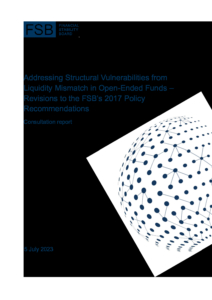Press enquiries:
+41 61 280 8477
[email protected]
Ref: 18/2023
-
Proposed revisions to FSB policy recommendations to address vulnerabilities from liquidity mismatch in open-ended funds (OEFs) incorporate lessons learnt since 2017 and aim to enhance the resilience of non-bank financial intermediation.
-
Revisions provide greater clarity on the redemption terms that OEFs can offer to investors, based on the liquidity of their asset holdings.
-
Revisions also seek to mitigate the potential first-mover advantage arising from structural liquidity mismatch in OEFs by imposing on redeeming and subscribing investors the costs of liquidity associated with fund redemptions and subscriptions.
-
The FSB’s consultation is taking place in conjunction with IOSCO’s consultation on guidance on anti-dilution liquidity management tools.
The Financial Stability Board (FSB) today published a consultation report on addressing structural vulnerabilities from liquidity mismatch in open-ended funds. The report proposes revisions to the FSB’s 2017 Policy Recommendations to Address Structural Vulnerabilities from Asset Management Activities. The proposals form part of the FSB’s work programme on non-bank financial intermediation (NBFI) and should be read in conjunction with the International Organization of Securities Commissions’ (IOSCO) consultation report providing guidance on anti-dilution liquidity management tools (LMTs).
The proposals build on the FSB’s December 2022 report on the Assessment of the Effectiveness of the FSB’s 2017 Recommendations on Liquidity Mismatch in Open-Ended Funds. The assessment report called for greater clarity on the redemption terms that OEFs could offer to investors, based on the liquidity of their asset holdings. The assessment report also suggested that there was room for greater use of LMTs, in particular anti-dilution tools that are intended to pass on the cost of liquidity to redeeming shareholders in both normal and stressed market conditions. The main amendments to the 2017 FSB Recommendations are:
-
Recommendation 3 – to provide greater clarity on the redemption terms that OEFs could offer to investors, based on the liquidity of their asset holdings. This would be achieved through a proposed bucketing approach, where OEFs would be grouped into different categories depending on the liquidity of their assets. OEFs in each category would be subject to specific expectations in terms of redemption terms and conditions.
-
Recommendation 4 – to ensure availability of a broad set of anti-dilution and quantity-based LMTs for use by OEF managers in normal and stressed market conditions.
-
Recommendation 5 – to achieve (i) greater inclusion of anti-dilution LMTs in OEF constitutional documents and (ii) greater use, and greater consistency in the use, of these tools in both normal and stressed market conditions. The objective is to mitigate the potential first-mover advantage from structural liquidity mismatch in OEFs by imposing on redeeming investors the costs of liquidity associated with their redemptions.
-
Recommendation 2 – to require clearer public disclosures from OEF managers on the availability and use of LMTs in normal and stressed market conditions. This aims to enhance investor awareness on the objectives and operation of anti-dilution LMTs.
The revised Recommendations, combined with the new IOSCO guidance on anti-dilution LMTs, aim to achieve a significant strengthening of liquidity management by OEF managers compared to current practices.
Responses to the consultation report should be sent to [email protected] by 4 September 2023 with the title “Revised OEF Recommendations”. All responses will be published on the FSB website unless respondents request otherwise. The final report will be published in late 2023.
Notes to editors
In 2022, the FSB assessed the effectiveness of its 2017 Policy Recommendations to Address Structural Vulnerabilities from Asset Management Activities. This assessment took place in parallel with IOSCO’s review of the implementation of its 2018 Recommendations for Liquidity Risk Management (LRM) for Collective Investment Schemes. While the assessment suggested that the 2017 FSB Recommendations remain broadly appropriate, it concluded that enhancing clarity and specificity on the policy outcomes the Recommendations seek to achieve would make them more effective from a financial stability perspective. Based on the findings of the assessment report, the FSB and IOSCO agreed to carry out follow-up analytical and policy work.
The objective of the policy proposals in this consultation report is to enhance the resilience of NBFI by addressing the vulnerabilities that drive excessive spikes in demand for liquidity during stress (e.g. by reducing liquidity mismatch) and by mitigating their impact on financial stability (e.g. by ensuring that redeeming investors pay the cost of liquidity). Further details on the FSB’s work programme to enhance resilience in NBFI can be found in its latest progress report.
The FSB coordinates at the international level the work of national financial authorities and international standard-setting bodies and develops and promotes the implementation of effective regulatory, supervisory, and other financial sector policies in the interest of financial stability. It brings together national authorities responsible for financial stability in 24 countries and jurisdictions, international financial institutions, sector-specific international groupings of regulators and supervisors, and committees of central bank experts. The FSB also conducts outreach with approximately 70 other jurisdictions through its six Regional Consultative Groups.
The FSB is chaired by Klaas Knot, President of De Nederlandsche Bank. The FSB Secretariat is located in Basel, Switzerland, and hosted by the Bank for International Settlements.
